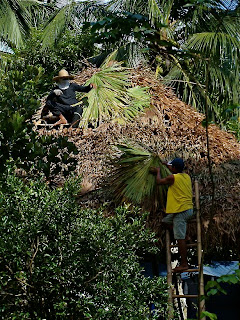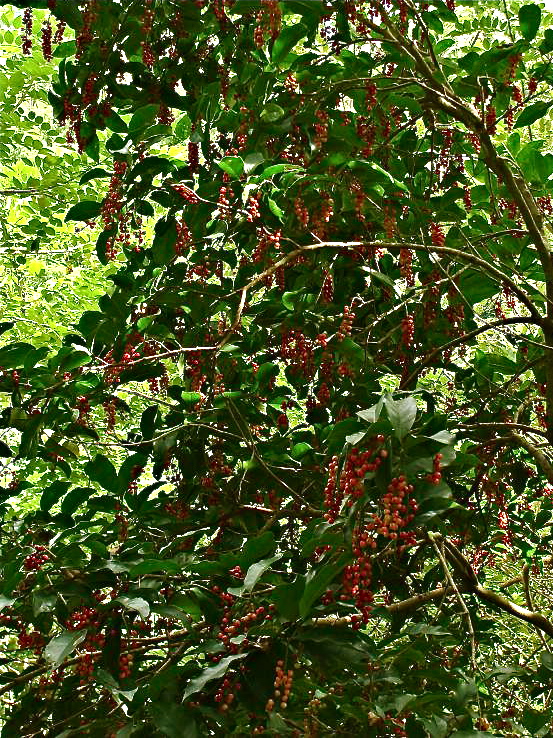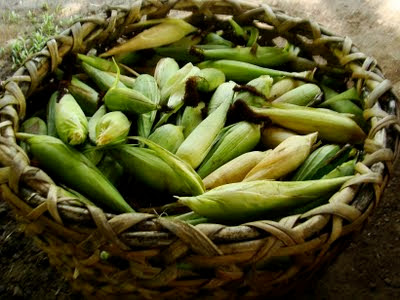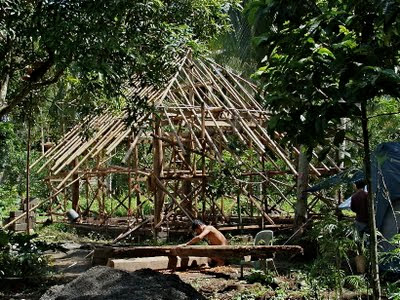One tree with fruit right now is bignây (Antidesma bunius), not a very popular fruit but a very attractive tree: it bears clusters of small berry-like fruits that simultaneously are in varying degrees of ripeness, so the colors in one cluster can vary from pale green to pink to bright red and black.
Apparently, it's not just me who's attracted to it but birds as well! Among the first fruit trees we planted in the gardens was this and this year, it has borne fruit, just on its third year (the photos though, are from trees that have been around much longer). Alongside arátiles, talisay, and various figs, the bignây trees hopefully contribute in making the farm a bird sanctuary.
I've read that it is widespread throughout Southeast Asia as far west as India, and that the Malay name is berunâi, which must have been the source of the name of the Sultanate of Brunei and perhaps even the island to which it is in: Borneo.
Life at Kaligátan Farm, a country house-in-progress in a coffee farm in the Malaráyat foothills.
The panorama on the sunrise side: an awesome view of Malarayat
The quiet panorama on the sunrise side of the farm: an awesome view of Mount Malaráyat and the river below the gap.
27 July 2011
25 July 2011
Corn
Anyone up for some corn? We have loads! We tried planting some a couple of weeks back and didn't realize it will yield this much! If you leave a whole ear on the stalk to its full maturity, the kernel itself (the one neatly on rows) will become the seed (Tag. binhî). On prepared, cultivated beds, we put up to three kernels on a small hole on the ground and in just a few weeks, they've become stalks and stalks (and even more stalks!) of corn. And some stalks have multiple ears, fantastic!
22 July 2011
Weekend
 |
| Photo by Anna Silos |
Today I don't feel like doing anything
I just wanna lay in my bed
Don't feel like picking up my phone
So leave a message at the tone
'Cause today I swear I'm not doing anything
 |
| Photo by Anna Silos |
No, I ain't gonna comb my hair
"Cause I ain't goin' anywhere
No no no no no no no no oh
 |
| Photo by Anna Silos |
Nothing at all, nothing at all...
(Lyrics from Bruno Mars' The Lazy Song, 2011)
19 July 2011
Bromeliads
The Bromeliad family has a wide range of types, predominantly epiphytic but some terrestrials too, and are endemic in environments as diverse as rainforests to deserts. When Christopher Columbus sailed to the "New World" in the late 1400s, he was given a fruit of a bromeliad plant which he liked so much and found so refreshing; he called it a "pine apple." Now how in the world that fruit be like an apple from a pine tree baffles me too. I guess it goes to show how startlingly "new" the discoveries were then.
There is always an appropriate bromeliad for any landscape design, be it under the sun or in the shade. Just like most plants, given the right environment, they do not require much attention and care, requires no pollination, and flourishes fairly fast.
In the gardens, some of them are mixed alongside other tropical plants but some I also put together in groups where they contrast and highlight each other's inherent beauty.

18 July 2011
White
Three fragrant flowers, lately in bloom: above left, gardenia (rosál, Gardenia jasminoides); above right, white ginger (cámia, Hedychium coronarium); and below, orange jasmine (kamuníng, Murraya paniculata).
17 July 2011
Left-over Lumber
There were some left-over logs from the previous owner by the time I was handed-over the farm; Mang Pilô humbly requested if I wouldn't mind that he cut three trees for him to use to build a new house: sangkáp sa báhay, he said. How can I refuse since he's grown these himself? I thought I'll offer to buy him new lumber instead but by the time I told him, the trees by then were beams and 2x2s. And that's how I came about having a couple of stumps; santŏl, dúhat, and in the photo above, muláwin (moláve), prized tropical hardwood.
Anyway, one day, we borrowed the chainsaw from the cooperative (which is impressively monitored by the barangáy) and had this particular muláwin piece cut.

The stockier parts I had squared off to get even blocks of lumber that can be used for pedestals or stools. Meantime, I'm still letting them air-dry for months, maybe even some years before finishing them.
The more irregular section, I had it sliced (above right and below). Now the noise alone of the machine was jarring, and the smell of the petrol and the industrial oil doused to lubricate the chainsaw gave me a headache; yet I hung on to watch since it was really exciting to see how each cut would reveal gorgeous grains, texture, and color; awesome work of nature.
That same afternoon, under the sizzling hot sun, we excitedly laid the pieces out on the grass and designed around them. It's strange that a lot of times, working with nature will often give you its own design solutions.
Now, some muláwin slices make up my pedestrian gate, complete with a let-through to allow us to reach in from the outside and work on the padlock!
14 July 2011
Housemates
I sure hope you wouldn't mind me posting about some of my housemates (there are two in the photo, one on the upper right corner; its colors show through the shaded part). Geckos go about their solitary lives not minding us and so we can also go about not minding them, right? They co-exist with us, preying on insects that would otherwise bug us, literally and figuratively: mosquitoes, gamú-gamó (that, I hate!!!), spiders, and apparently even small rodents.
Their croaks animate what would be otherwise boring evenings. Tú-kôh, tú-kôh, they vocalize and will make us scramble for flashlights to find them and watch their fascinating colors. Scientists have been trying to study and mimic their dexterity in the hope they can micro-engineer products using similar anatomy. Velcro was inspired from a shedding dog, and now self-cleaning windows are being devised by observing lotus flower behavior (which we incidentally have in the garden too). Bio-inspired engineering is the way to go, and we may start seeing our housemates in a totally new light.
So please, legal or illegal traders, just let them be.
12 July 2011
Silángan
Since Day 1, I've been amazed at how eloquent the locals are in expressing themselves. The Batangueňos, or at least my neighbors in San Celestino, have an immense yet healthy pride of place and of their identity, and this is most evident in their language. Of course, I speak Tagalog which is supposedly the same, but their Tagalog is THE Tagalog! And a lot of times, until now, I ask them to translate to "Manila" Tagalog what they say.
Anyway, one of the most beautiful words I began to appreciate since I moved to Lipa is silángan. In Filipino class, we were taught that this is Tagalog for "east," and it is. But when I speak to them and they refer to something somewhere beyond, eastward, they say silángan when they mean "that direction, where each day is born."
Ahhh, so THAT is SILÁNGan; a place to give birth. What a romantic word to refer a mere compass point. I don't know if any of you are with me on this, maybe you have to hear it and not read it to empathize where I'm coming from. But when I listen to them, their navigation sounds so natural and organic to their "now" that it just makes so much sense.
Gee, makes me wonder, what else don't I know? Naturally, the next question is: so what is kanlúran? It turns out it's from the verb kanlúng, sounds familiar but honestly, I do not know what it means. Apparently, it's to seek shade or to hide under something, as in kumanlúng ka díne sa lílom nang di ka ma-ampiyasán (stay under [our roof] here so the rain won't get to you).
Okay, enough in the meantime. I told you their Tagalog is different.
Okay, enough in the meantime. I told you their Tagalog is different.
11 July 2011
Heliconias

Heliconias are among the most attractive plants in a tropical garden, and they're so easy to grow! If you have a relatively big space, try planting some of these strikingly colorful varieties. Before I set up 1784, I would stubbornly grow them in pots in Manila which is impractical since they are bulky and need room to grow underground and keep itself upright.
They are not endemic to the Philippines but instead, are originally from the Caribbean, Central and South America. But they easily adapt to our conditions and I don't think they pose any harm to our indigenous environment. On the other hand, they enhance the ambience of any tropical setting.
Quite a number of people mistakenly call these plants (no matter what variety) as Bird of Paradise, which is a totally different plant altogether. In fact, that is more closely related to the Traveler's Palm than anything else. I think what confuses people is because all three of them (like still a big number of plants) produce colorful bracts that hold the true flowers inside (some just the size of pinheads).

They're very useful for simple flower arrangements since they're big and will hold up even by itself with some simple greens. Best of all, they keep long! Just put some water on a vase or a bottle, enough to wet the cut tips and they'll stay nice and colorful for even more than a week.
08 July 2011
Avocados
What's in season now this July is avocados! It's not top of mind for me since I don't usually see the trees that much and they aren't that many. But over breakfast, the staff prepared sliced avocados and home-grown bananas with milk for dessert and later found out, we had a basket-ful to bring back to Manila!
It's easy to grow: back in Science class in elementary, we were asked to bring a seed, place the lower half on a jar full of water and see it grow roots and germinate in no time.
Avocados (Persea americana), originally from Central America, is a great source of protein and good cholesterol. It's good to use for salads and sandwiches, substituting it for greens, provided it's not yet that ripe (and mushy). This season, we'll finally learn to make guacamóle which would be very good to side with carne asada, nachos, and tomato salsa!
It's easy to grow: back in Science class in elementary, we were asked to bring a seed, place the lower half on a jar full of water and see it grow roots and germinate in no time.
Avocados (Persea americana), originally from Central America, is a great source of protein and good cholesterol. It's good to use for salads and sandwiches, substituting it for greens, provided it's not yet that ripe (and mushy). This season, we'll finally learn to make guacamóle which would be very good to side with carne asada, nachos, and tomato salsa!
07 July 2011
05 July 2011
Constructing the Cabaňa
 |
| Still-fresh anahaw leaves right after installation. |
It wasn't until end-April 2009, the day after San Celestino's fiesta, that we started constructing the cabaňa, my pilot project. For months, I visualized in my mind how to plan the different areas: the gates, the driveway, the site of the future house, the water lines. Coming from an urban, technocratic background, everything seemed so abstract, imprecise, and full of infinite variables.
Moreover, I have been putting off building since I had no clue how best to deal with my circumstance. First, I have bought an old house for its lumber and have just been on storage for months. I've been to many places that have re-used old wood and I want it for my place too. Buying it was easy; what threw me off was the logistics of transporting, storing, sorting, and selecting. When I was still purchasing it, I had so many design ideas in mind. But when I was already confronted with the ten-wheeler truck full of narra planks and muláwin posts (below), I was at a loss where to start.
 |
| The muláwin posts are neither straight nor even and just drawing them, let alone putting them up and keeping them there to hold up the roof, baffled me no end. |
Then I remembered another artist, Ugu Bigyan whose garden and workshop I've thoroughly enjoyed. I thought I'll call him up to introduce myself and consult, especially since his place in Tiaong, Quezon is just a half hour's drive from us. Fortunately, it turns out that he actually accepts construction work and not only did he take up my project but it was also the beginning of a good friendship.
The design was very basic: a four-post hut using my muláwin posts, bamboo rafters and an anáhaw roof. We agreed on a budget too, and a time frame, more or less. He sent to the farm his core group of skilled and trusted carpenters/artisans and I would always excitedly drive more often than before to check on the progress.
Mid-stream, someone miscalculated the length of a beam...
... and instead of re-working it, we decided to extend the hut by adding two more posts.
 |
| Manually tying the bamboo rafters together with uwáy (rattan). |
 |
| Weaving the anáhaw leaves onto the bamboo frame. |
Soon after, they started working on the roof and that changed the over-all atmosphere altogether. After all, the primary purpose of the hut really is to literally have a roof over one's head. The natural, breathable material cools the interior significantly and has so far been maintenance-free for two years now.
By adding two more posts to the left, the six posts were no longer equidistant. We thought it best to build a partial wall on the backside, not only for protection from the elements but also to create a portal/foyer-like space on one side. Serendipitously, the wrong beam length produced an even better outcome.
Also, it appals me to see black (or even worse, green!) nylon mesh on top of natural roofs, to hold it down and keep it pressed even on the windiest days. A more natural solution, though more laborious to make, is a bamboo mesh which is locally called sála (the same Tagalog word for "sift").
I also put together some hand-me-down furniture from my grandparents' house, some teak pieces that will hold up well to the elements, a rattan duyán (hammock) handmade by my staff's uncle, and lots of cushy pillows to make the place more comfortable.
July Bird of the Month
 |
| White-throated Kingfisher |
04 July 2011
Frangipani
Planted around the gardens are trees that produce fragrant flowers, and among the more prominent ones are frangipanis (Plumeria, Tag. kalachúchi) of various colors but all sweetly-smelling nonetheless. The trees have a beautiful free-form, almost sculptural shape, its trunk a textured grey. Gardeners patiently prune the trees even through long periods of time just to achieve the perfect stance.
Ours are still pretty young or were only transplanted a couple of years back, yet they flower profusely and lend a more sensory experience in the gardens.
Ours are still pretty young or were only transplanted a couple of years back, yet they flower profusely and lend a more sensory experience in the gardens.
Subscribe to:
Comments (Atom)








































